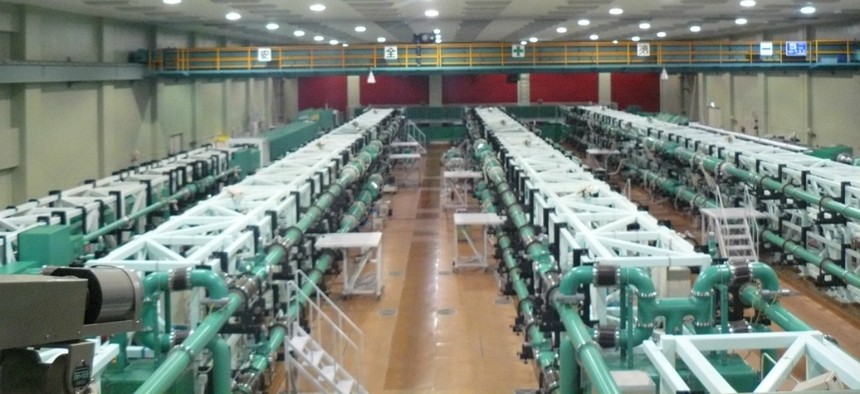
The GEKKO XII laser, at the Osaka University's Institute for Laser Engineering. KASUGA, Sho via Wikimedia Commons
This Isn’t The Death Star Laser You’re Looking For
Japanese scientists have created the world’s most powerful light beam, but its military use is limited.
Researchers at the University of Osaka have built a 2-petawatt laser — that’s 2 quadrillion watts of sweet, sweet directed power, orders of magnitude greater than today’s most powerful military lasers. Naturally, the announcement was immediately met with comparisons to the Death Star .
The Osaka laser system, called Laser for Fast Ignition Experiments, or LFEX, is not intended for military use, but that amount of power has clear military applications. Compare it to today’s cutting-edge military lasers, which include the 30-kilowatt Laser Weapons System currently mounted on the amphibious warship USS Ponce in the Persian Gulf. The LaWS has never been used in combat, but it took out several moving targets in a November demonstration.
In March, Lockheed Martin announced that they had demonstrated their own 30-kilowatt laser, the Advanced Test High Energy Asset, or ATHENA, which burned a hole in a car one mile downrange. In June, Germany’s MBDA Deutschland announced that their 40-kilowatt laser had knocked drones out of the sky nearly two miles away.
Lockheed is also working on a 60-kilowatt laser for the Army, and has said that 300-kilowatt laser, perhaps powerful enough to down a cruise missile, might be just three years away. Meanwhile, the Defense Advanced Research Projects Agency, or DARPA, has funded research into a 150-kilowatt solid-state lase r, aiming for a final product that’s “ten times smaller and lighter than current lasers of similar power” for use on planes and jets.
In terms of sheer power, the Osaka laser makes these look just pitiful. And it’s not even the first petawatt laser, nor the second. In 1996, Lawrence Livermore National Lab announced that they had “passed the petawatt threshold” with a laser called, straightforwardly, Petawatt. And until the Japanese breakthrough, the reigning king of lasers was the 1.1-petawatt Texas Petawatt Laser at the University of Texas at Austin, unveiled in 2008.
So the Japanese laser is impressive. But, as previous research has shown , it doesn’t rise to Death Star level. In fact, you couldn’t use it to shoot down a satellite from Earth.
“If one wanted to destroy a satellite, the Japanese LFEX laser would not be the answer, as it would not propagate far through the atmosphere — even if it could be pointed towards the satellite,” said Michael Donovan, the associate director of the Texas Petawatt Laser program.
But if you can shoot a 30-kilowatt laser for more than a mile, why can’t you shoot a petawatt laser into space? Turns out that petawatt lasers only work in a vacuum, because they ionize the air that they come in contact with. That’s the difference between a “high-energy laser” of the military variety versus a “peak power laser,” like the one in Osaka.
“The higher you get, the thinner the atmosphere. So a laser launched in space could propagate, but a petawatt laser is too large to economically launch into space,” said Donovan.
Also, there’s a big difference between power and energy. Power refers to the rate at which energy is delivered. The Osaka laser delivered its pair of petawatts in a single picosecond — a nearly unimaginably short time — so the actual energy delivered didn’t amount to much. Donovan does the math: “The Texas Petawatt Laser delivers about 150 Joules of energy in 150 femtoseconds. That is 1 petawatt. A hard tennis serve is around 100 Joules of energy. A femtosecond is a thousandth of a millionth of a millionth (10^-15) of a second.”
Your satellites are safe from Death Star lasers, for now.




